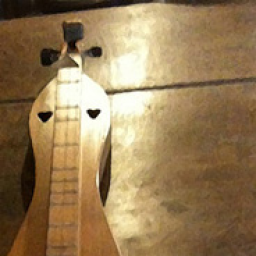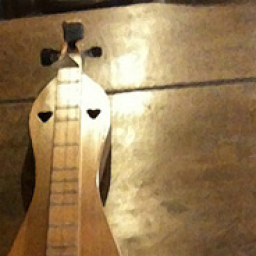Three Strings or Four ?
General mountain dulcimer or music discussions
Nimrod, you should be aware of this little bit of confusion for new players:
Here are some explanations to clarify what people are referring to when talking about number of strings on mtn dulcimers:
1) the most common setup as a "four string dulcimer" is 1 heavy bass string, 1 medium weight middle string, and a PAIR of thinner melody strings- which are close together, are usually tuned to the same note, and are played as though they are just one string- that kind of close pair is called a "course" or "double course". That dulcimer is very common and is played as though it has 3 strings, but the melody 'course' is really 2 strings close together and played as though they were 1 string.
(I should also mention that just because this outer light string is called the melody string does not mean you cannot play melody notes on the other strings as well, it's just a convenient traditional name for the string because: in traditional or noter style of playing, only that string is used for playing a song's melody..nowadays there are various styles of playing that use other strings for melody playing as well, but that's beside the point of my explanation)
2) Many people do not have, or purposely remove, one of the pair of melody strings and simply have 3 strings on their dulcimer: a bass, a middle, and a single melody string . They might choose to do this because it's easier to play in fingerpicking style that way, or because they feel awkward fretting a pair of strings, or simply because they don't like that fuller sound of the double course...they want to even the sound out between the different strings.
Another popular meaning when you hear someone talk about a "four string dulcimer" is:
3) four equidistant strings . This is when you have 4 strings, all spaced equally apart from each other , in various thicknesses (usually spanning heavy to light) tuned to a tuning of your choice. In this setup, there are no 'double courses' or pairs of close together strings. All four strings are equal distance apart and are tuned and played as individual strings. This setup can give you additional choices for getting various notes and/or chords while playing...as compared to a 3 string dulcimer as I describe in example 2).
----------------------------------
A double-melody-course 4 string dulcimer will have 4 tuning pegs and its nut and bridge string slots will be cut to allow the doubled pair, but you can always just remove one of the pair and play it like a 2) three string dulcimer- you'd have one peg with no string wound on it. Also, as long as the dulcimer has four pegs, it can simply have its nut/bridge slots changed or added to enable one to convert it quickly to a 4 equidistant dulcimer. Both my dulcimers have 4 tuning pegs and have additional nut/bridge slots which allow me to switch if i wanted to- to any of the above three setup,s by changing/adding/removing strings.
Probably the most basic setup for a beginner would be setup #2 above- a simple 3 string dulcimer. Many 3 string dulcimers have just 3 tuning pegs. These obviously cannot be converted to either 4equidistant setup or to a double-melodystring setup, because it'd be difficult to add another peg to the peghead...you can't have a string without its own peg or pin to tune it with. But many folks don't care about that anyway because they adore their 3 string dulcimers just as they are. You have all the same notes available to you on a 3 string dulcimer as you have on a dulcimer with a doubled melody course (examples 1) and 2) above).
One other detail is that most tablature and books available to players is geared towards the 1) and 2) setups. However, that does not stop dedicated 4equidistant string players from having a total blast and becoming wonderful players. FOTMD has a Group for 4 equi players- to learn more: Four Equidistant String Players Group
Any of the 3 setups above are beloved by many and are very popular. There are also more variations- 5, 6 string dulcimers, etc, but I'd say those are less common and not as recommended for a beginner to start with.
Hope this helps.
P.S. I moved this thread to the general dulcimer forum, instead of the 'site questions' forum.
updated by @strumelia: 01/14/16 11:56:14PM
















 :
:



 Tunes can be at varied tempos...some can be expressive and slow while others can be fast and lively. Then everyone can have a good time!
Tunes can be at varied tempos...some can be expressive and slow while others can be fast and lively. Then everyone can have a good time!
 All I ask is that we be respectful of people's names and reputations.
All I ask is that we be respectful of people's names and reputations.

 Hope you all enjoy this new feature.
Hope you all enjoy this new feature.
